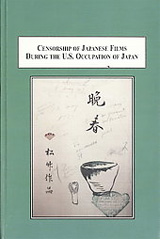 The publication date for Lars-Martin Sorensen‘s new book Censorship of Japanese Films During the U.S. Occupation of Japan: The Cases of Yasujiro Ozu and Akira Kurosawa was supposed to be October 30, but Amazon.com and Amazon.co.uk already list the book as “in stock”, although the former only has one copy left, and the latter notes a 10-13 day dispatch window.
The publication date for Lars-Martin Sorensen‘s new book Censorship of Japanese Films During the U.S. Occupation of Japan: The Cases of Yasujiro Ozu and Akira Kurosawa was supposed to be October 30, but Amazon.com and Amazon.co.uk already list the book as “in stock”, although the former only has one copy left, and the latter notes a 10-13 day dispatch window.
As the title indicates, the book investigates how Japanese cinema was affected by and dealt with film censorship during the post-war American occupation of Japan (1945-1952). More specifically, the author concentrates on the cases of Yasujiro Ozu and Akira Kurosawa. The product description reads:
The introduction discusses the prevailing narrative of the relationship between victors and vanquished, which has the Japanese in the role of the good losers and the Americans in the role of the good winners. This powerful historical discourse of the benevolent occupation rubbed off on film historical writings.
As a consequence, the analysis of resistance in the occupation films of Ozu and Kurosawa is virtually nonexistent. Since meaning is made by movie-goers, I present a general outline of the interpretive framework peculiar to Japanese audiences during the occupation in chapter two. Subsequently, the history, structure and daily practice of U.S. censorship is described.
The analysis of films, film criticism, and censorship documents on Ozu’s and Kurosawa’s films show that both directors repeatedly probed the limits of censorship, at times dodged censorship and frequently managed to denounce the occupiers and their imposed modernization. Ozu’s resistance was especially concerned with the status of women in contemporary Japanese society. Kurosawa continued to foreground many of the nationalist themes of his wartime propaganda films in his occupation films, and tended to dress his criminal characters up as westerners with the presumable intent to denounce both the occupiers and those Japanese who embraced the ways of the occupiers.
Finally, the book argues that Kurosawa’s international breakthrough, “Rashomon” (1950), lends itself to an interpretation bordering on anti-Americanism by the contemporary Japanese audience.
Based on the description above, I am certain that the book will generate some discussion here! As I have not yet received my copy, I cannot comment further.
Lars-Martin Sorensen (actually “Sørensen”, but I’ll go with the publisher’s version) is a postdoc research fellow at the Section of Film & Media Studies, University of Copenhagen. According to the author blurb, he has published numerous articles on Japanese film, is a co-editor of the peer reviewed film journal Kosmorama, and a member of the steering committee of the Nordic Association for the Study of Contemporary Japan (NAJS). Meanwhile, the book’s foreword is written by none other than Stephen Prince.
Full contents list:
- Foreword by Stephen Prince
- Acknowledgements
- 1. Introduction
Sources and structure of this volume
Aims and methods
The ‘180-degree thesis’
Historical and theoretical perspectives
Occupation film studies - 2. Framing the occupied mindset: the core audience
The audience – age, sex and profession
Schooling
Military training
The news media
Film
The case of Japan in Time of Crisis
Indoctrinating associations
The user’s perspective
Internalization or public transcript?
Perspectives for the analysis of the occupied cinema
The key models - 3. Players in the arena of censorship
The practices of censorship
CI&E and CCD, cooperation and conflict
The ‘opening hours’: popular sentiment mirrored?
Ways and means of subversiveness
The transition to Japanese censorship - 4. Directing the national family: the occupation films of Yasujiro Ozu
Ozu studies: A question of style
A sustained critique
Ozu’s wartime films
Record of a Tenement Gentleman
A Hen in the Wind
A pilot balloon for Late Spring?
Late Spring
Contemporary critical response
Synopsis
Manuscript
The film versus the scenario
A structure of places
Characterization by means of beverages, food, and seating
Repetitions and differences - 5. No regrets for whose youth?: the occupation films of Akira Kurosawa
Kurosawa and wartime censorship
Ambiguous wartime collaboration?
Father-son relationships on and off screen
Hard work as the best patent of nobility
Kurosawa’s occupation films: an overview
No Regrets for our Youth
Plotline
Factual background for the fiction
A democratization film?
The use of history
Cinematic duplicity
Drunken Angel
The plotline of the censored film
The synopsis
The first manuscript
The revised script and the film
The birth of a new motif
Westernization as denunciation
Administering the dos and don’ts
The audience
A tug-of-war
Stray Dog
The synopsis
Yoshimoto’s analysis
Viewing Stray Dog
The third way
Rashomon: an interpretation
Recontextualizing the reception
Adaptation, adjustments, and allusions - 6. Narrowing the concentric circles: results and perspectives
Results
Why this late?
Sameness and difference - Bibliography
- Index
For more information about the book, see the section on Akira Kurosawa books.





